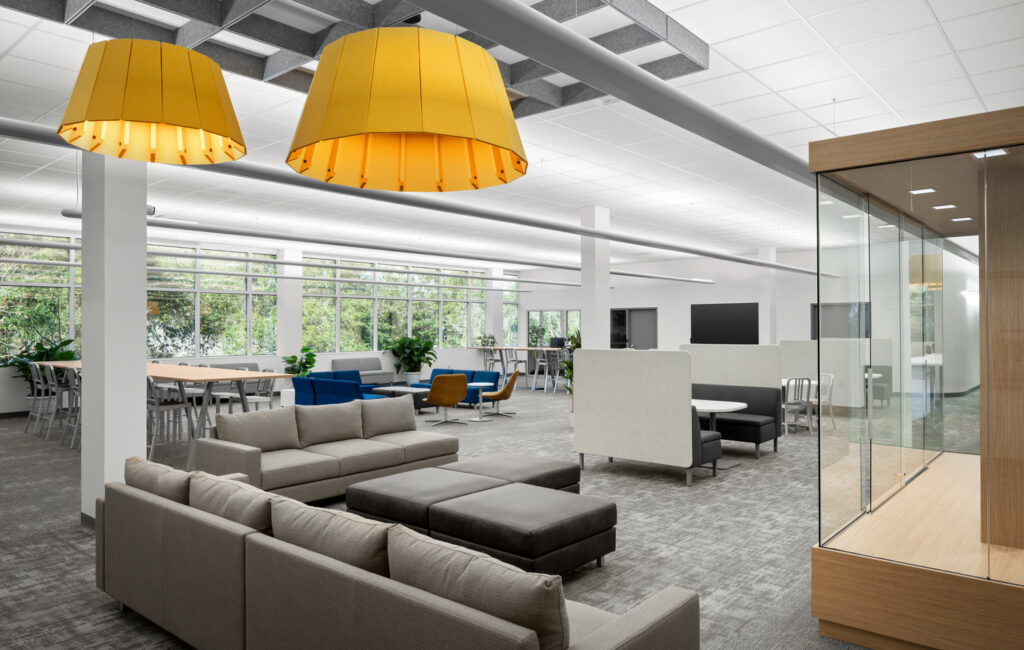When thinking about a space, we often focus on the visual aspects, but acoustics—how sound behaves in a space—also plays a vital role in shaping our experience. Sound affects comfort, communication, and even how people perceive a space. When acoustics are prioritized early in the design process, you can ensure that your space will sound as good as it looks.
How Acoustics Shape Space Experience
Whether it’s a performance hall, a classroom, or a cafeteria, acoustics matter in how people interact with and perceive a space. Poor acoustics can diminish the quality of even the most visually impressive architecture. Imagine entering a large, echo-filled lobby where every sound bounces around, making it difficult to hear. It's disorienting and unpleasant. On the other hand, good acoustics enhance the experience of a space, making it more enjoyable and functional.

Booth seating at the UF Malachowsky Hall for Data Science and Information Technology provide acoustic privacy for focused work or small meetings. Design partner: Bohlin Cywinski Jackson
Different Spaces, Different Needs
Acoustic requirements vary based on the type of space. Performance venues, for instance, demand precision. The acoustic design in a concert hall or theater ensures every sound—whether it’s music or spoken word—is heard clearly and as intended.
Multipurpose spaces, such as gymnasiums, present a different challenge. These areas host a variety of activities, each with its own acoustic needs. The acoustics must accommodate everything from sporting events to assemblies without compromising clarity or comfort.
In classrooms, good acoustics are essential for student engagement and learning. If students struggle to hear the teacher, they are less likely to stay focused, which impacts their overall learning experience. Similarly, laboratories require acoustic considerations to ensure safety and effective communication.

An auditorium style classroom at Chi University
Common Misconceptions About Acoustics
Acoustic planning should begin early to create a balanced, functional space. One common misconception is that acoustics can be addressed later in the design process. In reality, retrofitting acoustics is not only more costly but also less effective.
Another misconception is that soundproofing walls and ceilings is enough. Even small construction details, such as door gaps or outlet placements, can undermine acoustic performance. Without proper planning, sound can easily travel between spaces, reducing the effectiveness of the design.

Multi-story volumes in the UF Malachowsky Hall for Data Science and Information Technology are open yet comfortable public spaces. Design partner: Bohlin Cywinski Jackson
An Agile Approach to Acoustics
In agile design, flexibility is key, and acoustics play a crucial role in supporting that adaptability. As spaces shift between different functions—whether it’s a meeting area becoming a collaborative zone or a quiet space transforming into a dynamic event hub—acoustic design ensures that sound enhances the user experience rather than detracting from it. By incorporating sound-absorbing materials, strategic layouts, and sound masking systems, we craft agile spaces that can maintain comfort and productivity across various activities:
- Sound Masking Systems: In open offices, sound masking helps reduce distractions and create privacy. These systems, which use a background sound to reduce distracting noises and increase privacy in a space, are an affordable and effective way to improve acoustic performance.
- Intentional Planning: We isolate noisy areas from quiet, sensitive spaces through careful planning. This ensures that key areas like classrooms or meeting rooms aren’t affected by external noise.
- Material Selection: We choose materials that enhance acoustics, such as sound-absorbing ceiling tiles or sound-diffusing wall treatments, to create the right environment for each space.
- Client Education: We work closely with our clients to explain the importance of acoustics, ensuring they understand how it impacts the overall success of their project.

The JAM Room in the Rock Church's North Campus Worship Facility hosts music for classes of all ages
Looking Ahead
As we move forward, acoustics will continue to be a key consideration in any Agile Design. By focusing on sound from the start, we create spaces that function better, providing an optimal experience for users. At Walker Architects, we design spaces that both look and sound right.

A welcoming breakout space in Trajector's headquarters looks and feels comfortable and inviting




No comments.